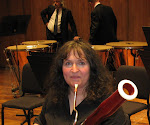During last night's Nutcracker performance I decided to change my fingering for the high A-B trill in the bassoon solo in No. 11:
For reasons I cannot explain, the high A-B trill fingering I have used ever since my very first Nutcracker is unreliable. I don't know why I remained loyal to this fingering:
Mysteriously, the fingering works perfectly when I first take the bassoon out of its case. The trill works quite a few times at first, and there doesn't seem to be any problem. Then suddenly, inexplicably, something changes and the fingering fails, with a cacking noise replacing the high B in the trill. Once this change occurs during a practice session or orchestra service, the cacking continues each time the trill is attempted! It's confounding.
It might seem obvious to some bassoonists that if the cacking begins only after repeated executions of the trill, the logical solution would be to not practice it before a performance. But I am too obsessive to restrain myself from testing it, over and over, before a performance!
Finally, in the middle of last night's Nutcracker, I decided to solve the problem once and for all. As long as other fingerings exist, why not find a reliable fingering for the High A-B trill?
Early this morning I pulled out my Cooper/Toplansky Essentials of Bassoon Technique. I tried all of the fingerings for that trill, thanking my lucky stars that there were so many choices, and decided upon the one that had popped into my mind last night during the Nutcracker:
This one never cacks, even the hundredth time it is played. It is slightly awkward due to the 2nd finger right hand having to go up when the 3rd finger left hand goes down, but my original fingering wasn't exactly easy either.
But a problem does exist. I have practiced the original fingering thousands upon thousands of times (ask any member of the Columbus Symphony). That fingering is in my DNA. Now suddenly I'm supposed to have a new (and awkward) fingering ready to go by tonight's performance?!
In the past when I've had to "reprogram" like this, I've used the technique of keeping the bassoon out all day (normally I put it back in its case whenever I'm not practicing) so that I can continuously pick up the bassoon and play the new trill fingering, within the context of the Nutcracker solo, then set it down and do something else briefly (or practice something else), followed by another go at the passage, ad infinitum, in the hopes that I can make the trill automatic by tonight. I have found that the most helpful thing I can do at this point is to remind myself before playing the passage to leave the 4th finger right hand on the F key for the A4 which begins the trill, since that is the most unusual and unnatural aspect of this new trill fingering. Whenever I do remind myself to leave the 4th finger on the F key, the trill is a success.
Have you ever encountered a problem with this trill? What was your solution?
.
Sunday Morning Music
-
John Taverner: O splendor gloriae The Sixteen: Harry Christophers,
COnductor O splendor of glory and image of substance God the Father
almighty, Jesus Chri...
2 days ago









6 comments:
The fingering that I've always used is your 'new' one. You're right, it's super reliable yet a bit awkward. I'd also opine that your frequent repetition program is probably the best way to learn it. As to whether to use the new fingering, that'll be a good question. W/O risk, nothing is gained. Even if you revert to your old one for this year, you can always re-learn it for next year, as with Nutcracker there always is a next year.
Here's my question: in the nasty triplets section in Act 1, do you use full fingering for the last two patterns or have you found a fake that works?
Arundonax, I'm glad to hear that you have always used my new fingering. I wondered if anybody used it. For some reason I thought that my original fingering was standard.
I use the full fingerings for the last 2 patterns in the nasty triplets section. I wish I had been able to come up with a fake, but no dice!
Betsy
Interesting! This is off-subject a bit, but you are using a different edition than we use in Houston Ballet. The very first note in your edition is G#; in our edition its a B tied from the previous number.
I have to try and learn the new fingering for a recording tomorrow. Thanks for writing such a detailed and interesting blog! joe x
Mike- this version is an arrangement by David Itkin. It differs greatly from Tchaikowsky's score.
Joe- Thank you, and good luck!!
Betsy
THANK you for keeping this blog alive and well in 2017! Forgot the A/B fingering AGAIN and a quick Google search led me to the solution.....thanks again, Marty (Kay Keneetit was one of the "sponsors" on the Car Talk program on Public Radio). :-)
Post a Comment